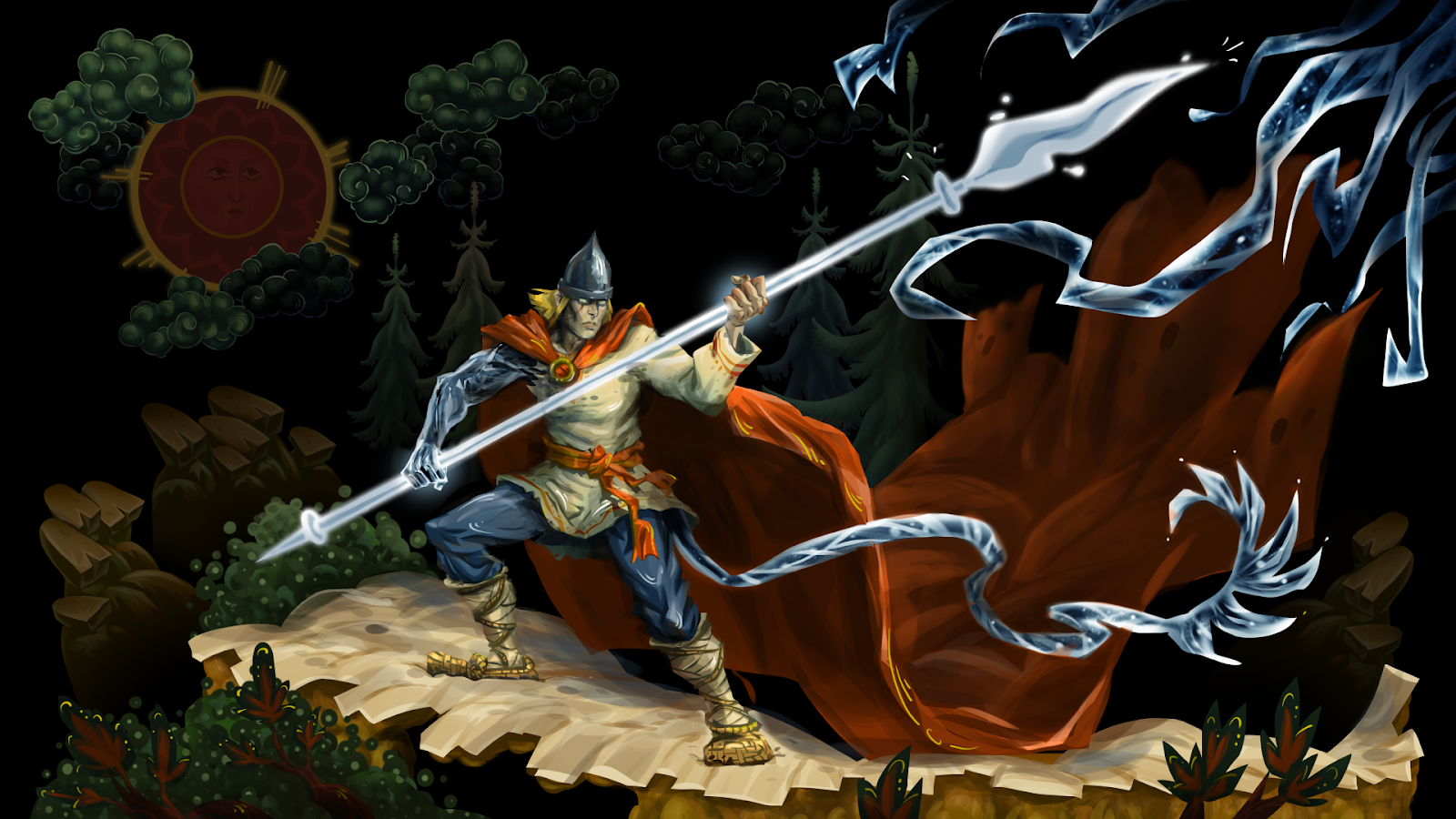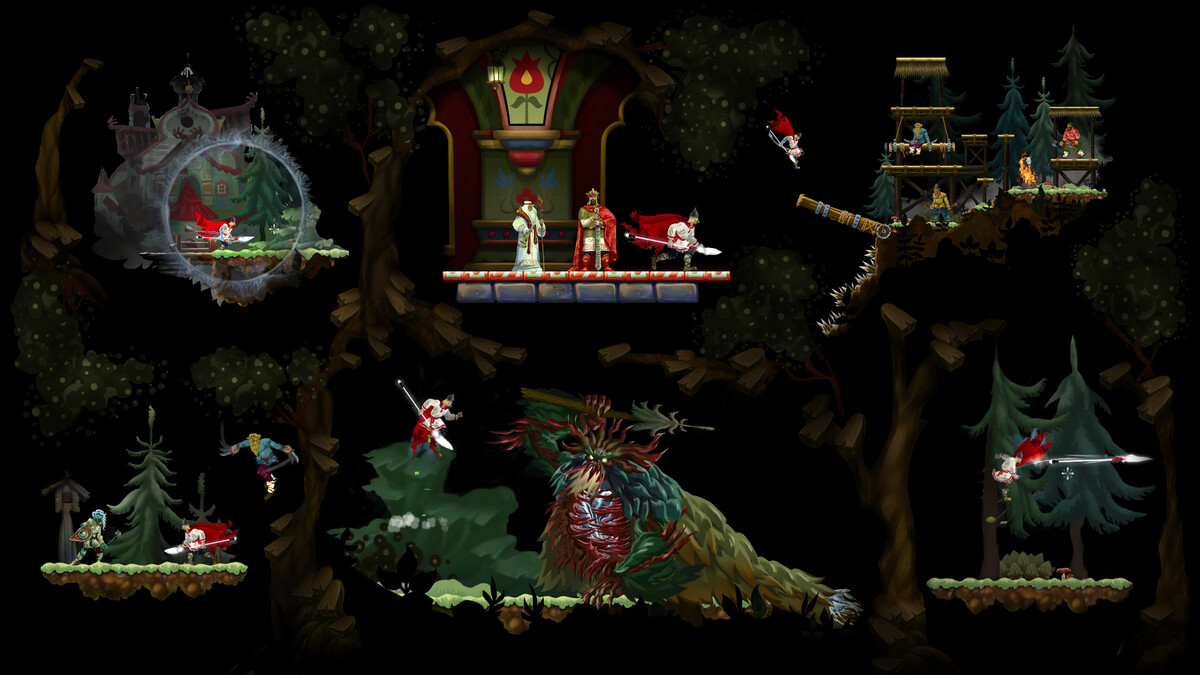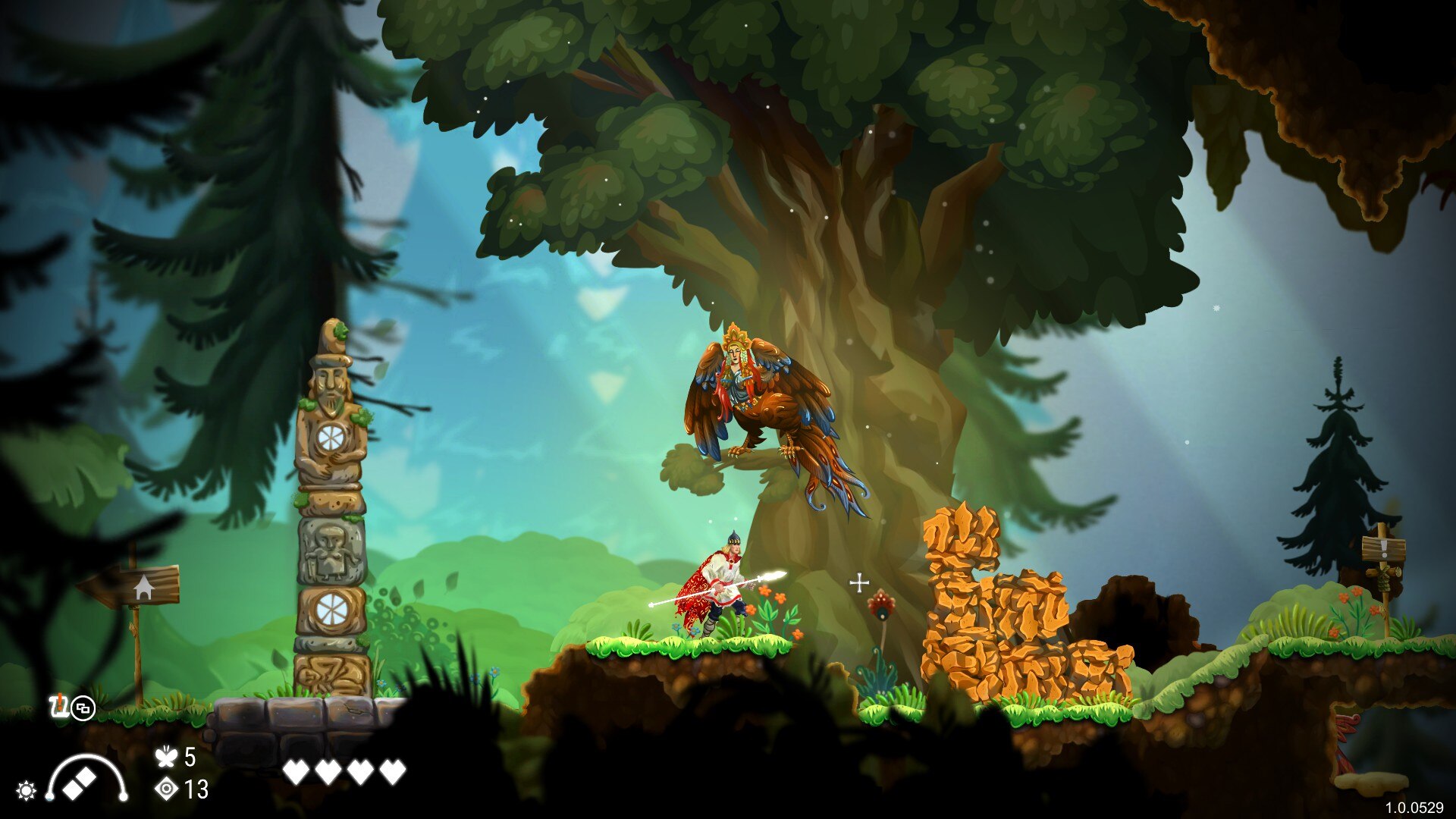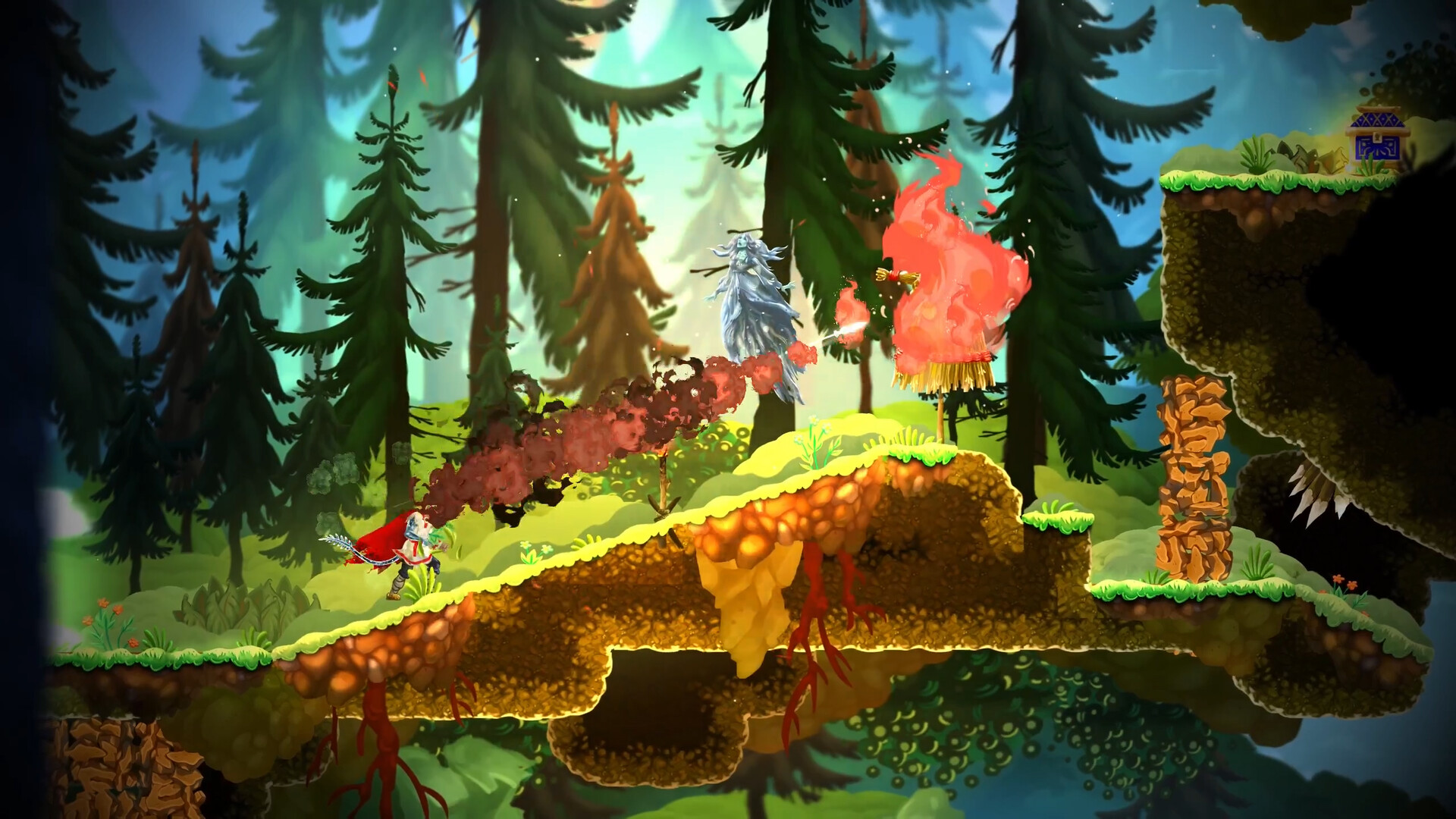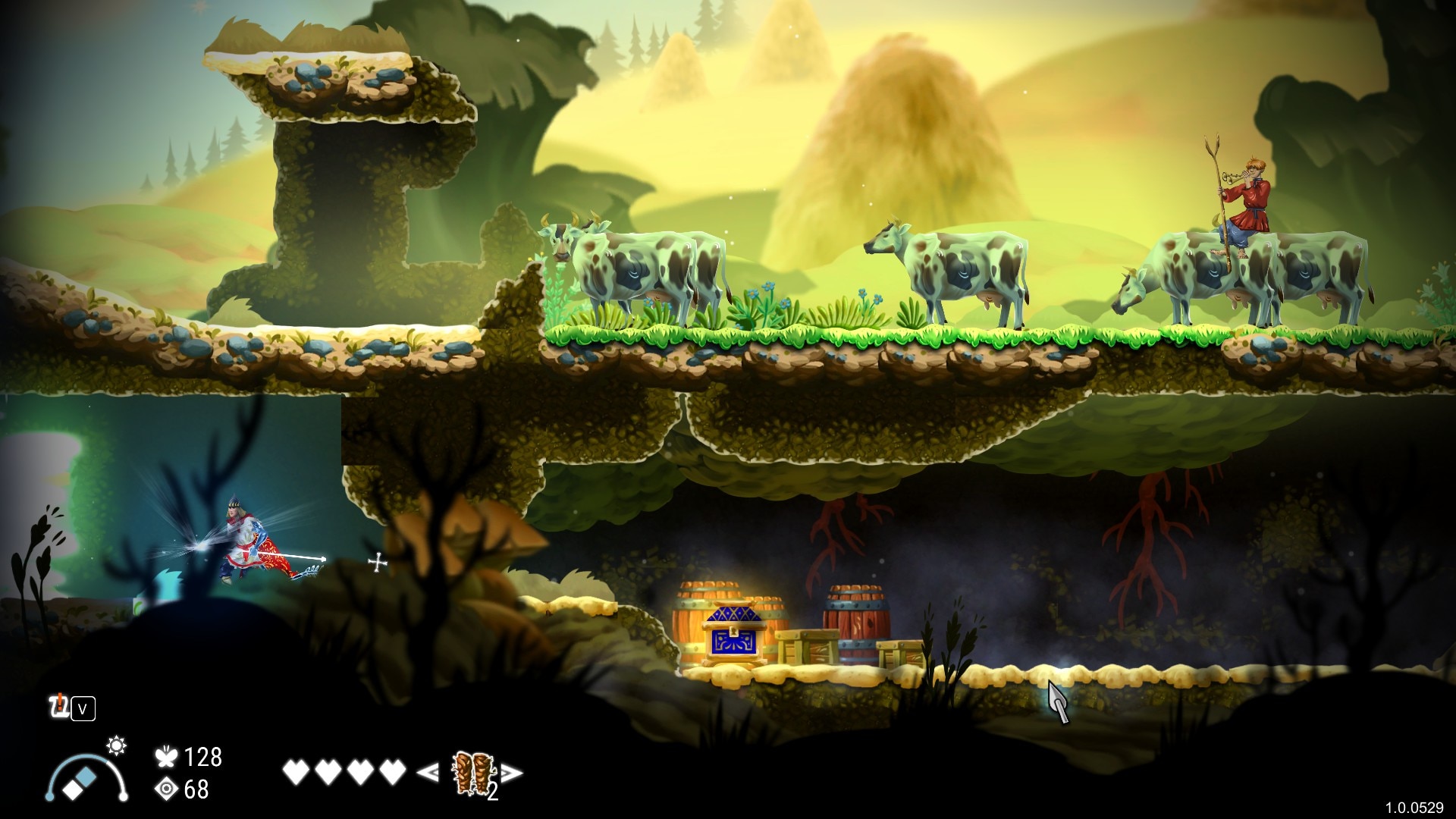"Initially, we wanted to make a PC clone of Splatoon," — an interview about the development of Slavania
In March, Slavania, the debut game by FrostLeaf Games studio, published by Game Art Pioneers, was released on Steam. We talked with Vladimir Averyanov, the game designer of the project, about how the metroidvania was developed based on Russian fairy tales.
Alexander Semenov, App2Top: Hi! Slavania is a project of three developers. You've been working on the game for three years, and what did you do before that?
Vladimir Averyanov
Vladimir Averyanov, FrostLeaf Games: Hello! Before that, we had worked in various IT industries. For example, Maxim, our programmer, worked at Motorola for a while, and Vova, our artist, worked at Telegram and on Smeshariki. As for me, I worked as a programmer in various companies, mainly in the b2b sector, but I was also involved in boxed products and hardware and software complexes. In general, there is a huge variety of non—entertaining projects behind my back.
In an interview earlier, you mentioned that at first there was a desire to make a game, and only then the studio itself.
Vladimir: Yes, FrostLeaf is a consequence of our desire to do something of our own.
Of course, everything could have turned out differently, but it so happened that at some point this desire overcame common sense and we set off on a free voyage.
How did the history of the project begin? Why did you decide to take up the development of a metroidvania in a Russian-folk setting?
Vladimir: Firstly, we have always been interested in folklore.
Secondly, who, besides us, would be better to talk about their own culture?
But in general, initially we wanted to make a PC clone of the Nintendo game Splatoon, in which squid men run around and shoot each other with paint - whose team painted over the most, she won. A brilliant idea.
We even managed to repeat the technology of painting all surfaces in 3D.
Why did the development stop?
Vladimir: We abandoned the idea pretty quickly because it wasn't original enough. Plus, it necessarily provided for multiplayer, which imposed a lot of additional restrictions (at least eight people should have wanted to play such a game at the same time, and you don't need to look for companions for a single-player game).
As a result, we decided to follow the classic indie path - to make a slightly arthouse, small—format two-dimensional game with interesting mechanics and eye-catching visual.
What sources did you use most often to work on the setting and graphics?
Vladimir: In terms of visual, we had our own bible, built according to all the rules — with our own palette and other subtleties of graphic production.
In short, the style was based on Palekh painting and the Byzantine tradition of icon painting. We were also guided by the desire to create a colorful and vivid picture. At the same time, it was very important to us that the graphics were not perceived as casual. We didn't want to mislead the players. Slavania is far from a casual game.
In working on the setting, quests and characters, we relied primarily on the works of Vladimir Propp, in terms of the history of religion — on Boris Rybakov. The stories themselves were taken either from Afanasyev's collection "Russian Folk Tales" or from other similar ones.
We also studied catalogs of archaeological finds of Veliky Novgorod, went to museums and looked at what certain household items looked like. It wasn't really necessary for the game itself, but trips to Izborsk helped me better immerse myself in the era.
How flexible is this setting for work? Isn't there a feeling that in some moments it is very limiting?
Vladimir: Strangely enough, but in the constraints there is just space for interesting solutions.
For example, in Slavania, all the characters speak a fictional language, very similar to some Old Russian or Polish, but absolutely meaningless.
This gibberish appeared due to the inability to afford a full-fledged voice acting. We didn't want to leave the characters completely mute.
When working on a fictional language, we partly relied on Interslavic, an artificial language of inter-Slavic communication, which in theory should be understandable to any Slavic, even from Macedonia, even from Bulgaria or Russia.
The fact is that in order to create the right atmosphere in the field of sound, we needed the necessary hooks with recognition. In the music and sounds of the environment, bells, orchestral instruments, and various approaches taken from classical compositions and Soviet cartoons dedicated to medieval Russia were responsible for this. The characters' replicas contain sounds typical of the languages of Eastern Europe and the frequency characteristics of the Russian language.
If we talk about the limitations imposed by fairy tales and images that are ingrained in the public consciousness, then at first we were quite free with the primary sources, probing how far we could go.
At some point, we had an underwater kingdom, which is described in Sadko. We decided that an important visual element would be various deep—sea things - tentacles and creepy underwater plants, which we would symbolize the world of death, something otherworldly (hello Lovecraft).
As a result, we went so far in our search that at some point Gorynych turned out to be with fish heads. But, thank God, we stopped there and came to the conclusion that classic characters should be classic with us.
So the main thing for us was to keep the feeling of a fairy tale.
So it turns out that in a sense we tried to fight genre restrictions, but in the end we accepted them, and, like cynics, found our freedom in this. After that, there was no more such throwing.
What became one of the main difficulties for the team at the first stage of development? What would you be happy to know in advance when starting to create a metroidvania?
Vladimir: We would be glad to know in advance how laborious the process of creating games is!
Our main weakness was our numbers. After all, doing such a big threesome game is necessary to have a sufficient level of courage, if you know what I mean.
If we talk about private moments, then I think we should have:
- it is better to carry out testing with porting earlier;
- pay more attention to the game's voice acting;
- Find a publisher earlier;
- It's better to plan;
- do it faster and do more.
And also, of course, to do what is necessary and what is not necessary — not to do.
But all this knowledge had to be acquired. Except from my own experience, it was impossible to do this. So it's all gone into our piggy bank, which will be useful when creating future projects.
You started the game page on Steam quite early. It appeared in early 2021. Did you already decide on the visual style then?
Vladimir: Yes, by that time we already had some idea of what kind of game we wanted to make, which mechanics would be emphasized.
But then we only had a set of demoscenes on one screen. It was proof of concept. Not even a vertical slice. There was no game, we were experimenting with basic mechanics, writing basic systems.
For example, if you look closely, you can see that in the first video, when walking, Alyosha had a reversal animation and moved quite differently than in the release version.
We didn't have full-fledged levels at that time, we only came up with a pipeline for their manufacture and wrote tools for it (various smart brushes, generation of some things, etc.).
By the way, we realized that we need such tools just while working on the prototype. Then it took several days to assemble one screen — you had to manually arrange each bush/stone/flower. Given that there were supposed to be hundreds of similar screens in the game, creating them without tools would have been an unrealistic task in terms of timing.
Have there been any conceptual changes since the creation of proof of concept? Or did you just decide not to deviate further from the initial tasks and vision?
Vladimir: No, conceptually everything was decided just at that time. All further development is already deep work and content creation.
Up to this point, we still had throwing in the direction of grim dark, such a dirty Middle Ages with cruelty, but at some point it came to the realization that we did not want to see the stories that we were going to tell in such a performance.
So we settled on a colorful visual.
Judging by the blog entries, the game was almost almost ready in October 2022, but at some point everything seemed to stand up. What happened?
Vladimir: I have to confess here. We couldn't meet the deadlines and we ran out of funding. In order not to close the project, we had to spend some time making money.
In one of the videos dedicated to the game, it was revealed that the studio did not raise money. There were no outside investors or government funding. In this case, what resources were used for development?
Vladimir: That's not quite true: I said that we did not participate in any government financing programs. We raised most of the money from a non-core investor.
In the summer of 2023, the game got a publisher — Game Art Pioneers. Can you tell us about the terms of the deal? What obligations has the publisher assumed?
Vladimir: I can't disclose the detailed terms, but Game Art Pioneers took over all the work on publishing and marketing the game, as well as on finding investments for the next projects in the Slavania franchise.
As far as can be understood from the press releases, which also fell on my mailbox, it is with the publisher that the promotional publicity of the title is connected. Here is the appearance of mead, and the support of the "Buranov grandmothers", and the appearance of the comedian Chebatkov as an NPC. The main question is: how did this affect the Vishlists?
Vladimir: Yes, due to the limited marketing budget, it was necessary to resort to various more creative concepts to promote the game, for which the emphasis was placed on collaborations.
It had a good effect. Since the announcement of the strategic partnership with Game Art Pioneers and to date, the number of vishlist has more than tripled. At the same time, not all collaborations have been played yet, we have saved some for later.
In other interviews, it was noted more than once that the game had playtests some time before the release. How important were they for the game? What did they show and what did you change in the end with an eye on them?
Vladimir: The playtests turned out to be very important. They even influenced the introductory video at the beginning of the game, which was completely redrawn, because the first version of the video greatly spoiled the impression of the game. I can't say that we are as happy with the current video as possible, but it was received better by the testers.
Of course, the playtests helped to find a huge number of bugs, which we fixed before the release. Because of this, there was even a delay in publishing the game on Steam, because we cleaned the game until the last moment and wanted to send the most final version for verification, although we could have done with an older one.
The game was released in mid-March. How difficult did it come out for the studio?
Vladimir: This is our first release, so we decided to collect all the cones in the forest and gain experience. We had a very successful presentation of the game, gathered specialized and non-core journalists, from whom we still receive positive feedback about the event, but from a technical point of view, there were still many problems in the game that we are still fixing, although, to be fair, by the summer the game should come in plus or minus perfect the condition. Unfortunately, it was impossible to delay the release even more, and now we are receiving revenue that can be used to improve the game and localization into other languages.
So I would say that the release was expected to be difficult, but we coped and are working on.
Have you already summed up the first results for yourself and for the project? And if so, what are they like? Conditionally, what happened, what didn't?
Vladimir: It definitely worked out:
- to create, if not unique, then quite original gameplay, which has something to surprise the players;
- to attract huge attention to the game for metroidvania (we continue to receive many positive reviews about the game, thanks to which we understand that the setting has reached the audience);
- to introduce a lot of Easter eggs in collaboration with real characters and brands, which almost no one has done before, except for the authors of major games like Atomic Heart and World of Tanks.
It didn't work out:
- polish the game to the desired state for release.
Now we plan to gradually release on other platforms, for which we have the opportunity to debug everything.
We are extremely grateful to the players who purchased Slavania in the first few days and give us a huge amount of feedback.
The game has a "mixed" average rating on Steam. How did you meet the critical reviews for the project? How much do you agree with them? Weren't there reviews not only about bugs, but also about game design?
Vladimir: We met stoically.
We fix bugs, and game design…
The player is guided by emotions: often what he complains about may not be the reason for his discontent. We understand this and remove annoying elements.
Some things were done by us quite intentionally, but against the background of bugs, it might not always be read. In any case, we read everything, and negative reviews are often even more useful for us than positive ones. Although, in my opinion, there are unfounded or overly critical ones
Another common criticism is for the graphics. Many compared it almost to graphics for mobile games. What do you think about it?
Vladimir: People say what they feel. We live in a time when phones will pull any 2D game and most 3D ones.
I guess most of the players here are talking about animations. It is made in the technique of skeletal 2D animation, and this technique was extremely popular at one time - due to its simplicity and cheapness — just on mobile platforms and in Flash games.
People see familiar things and they associate them with Flash games, with mobile games. On our part, this could have been avoided if we had used a different visual style. For example, pixel art. But the way we went gave us a choice of either skeletal animations or frame-by-frame ones. We haven't grown up to frame-by-frame yet, but we will definitely grow up.
The project has relatively few reviews right now. What kind of sales are we talking about? How do you plan to increase sales further?
Vladimir: The game was expected very much and for the release, after all the information guides and interviews, the vishlist grew especially strongly. On the day of release, we even got to the Steam homepage, and not only to the "sales leaders", but generally to the very top of the page.
Unfortunately, due to a technical delay in the release, we only stayed there for a day, because the spring sale had already begun in the evening. Nevertheless, we stayed in the sales leaders for another three days, but due to bugs, the players quickly reduced their activity, although the vishlist continued to grow. In fact, now a huge number of people are waiting for us to polish the game in order to buy it after that.
Now we are not only actively cleaning out bugs, but also making many changes based on the results of collecting feedback from the audience, for example, improving the interface, making some objects more readable, reducing the timings of interaction with NPCs, etc.
By the summer, we should have a completely clean game, maybe with some minimal bugs (because it's impossible to clean up everything at all). I think that as part of the summer sale, players will be able to safely buy and enjoy the world of Slavania. Plus, we still have a number of collaborations in stock, which we are saving until the release of the "final" patch.
What awaits the project and the studio in general next?
Vladimir: A lot of systematic work. We wanted to release the game at the end of 2023, but the publisher convinced us to postpone the release, which gave us the opportunity to warm up the audience well and do a great job of finishing the game. In parallel, Game Art Pioneers is communicating with many foreign partners and we plan to release Slavania on various platforms.
In addition to localization into various languages and porting to other platforms, we continue to work on the DLC for the game, we have a lot of interesting ideas that we want to implement. And Slavania itself has already turned into a franchise, within which we will make another (and maybe more than one) game.
So far, we have covered only a small part of the audience that we plan to reach. More than half of the vishlist accounts for the countries of the West and Asia (for which we are preparing localization), many domestic players are waiting for patches, so sales will slowly grow, and maybe even grow sharply with the release of DLC.
